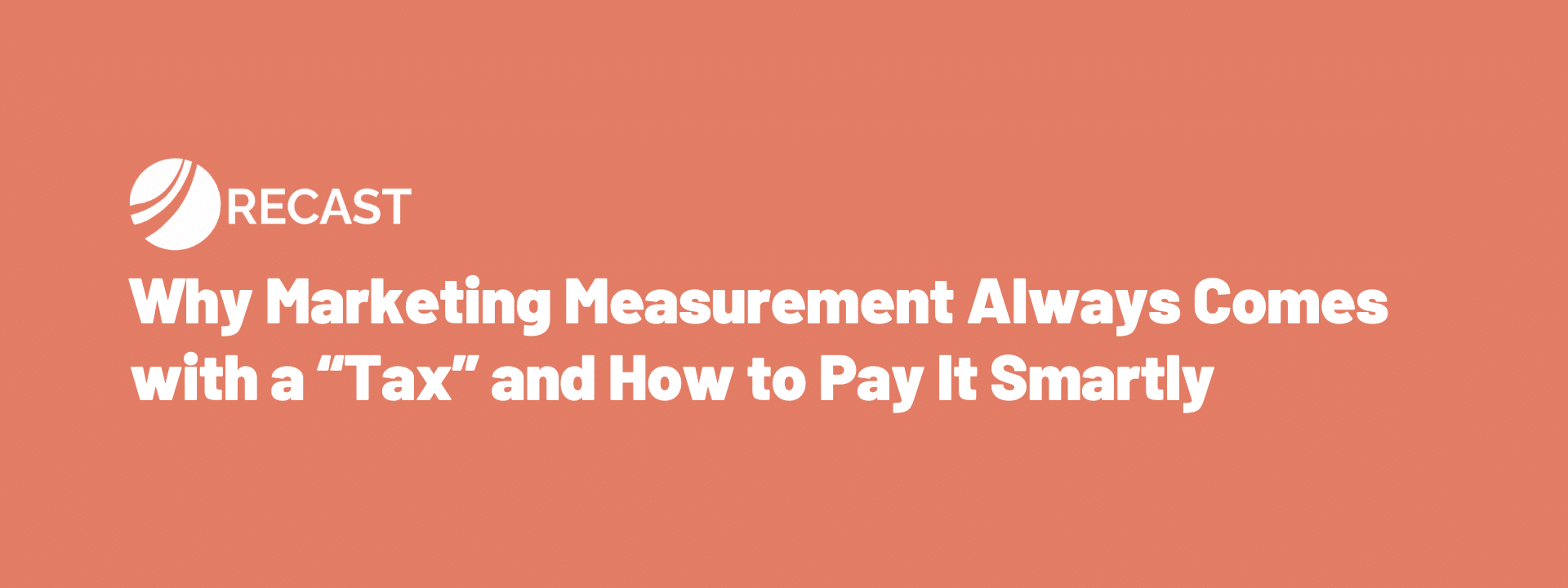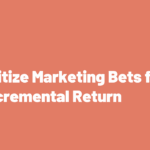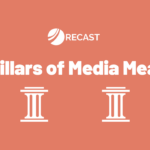Every marketing measurement strategy comes with a cost.
Whether you’re running incrementality tests, MMMs, or lift studies — there’s always a tradeoff. Andrew Covato calls this the “measurement tax” — a concept he shared in our Recast Marketing Measurement Coffee Break. This tax comes in two forms: explicit and implicit.
An explicit measurement tax is what most marketers fear.
It’s the upfront cost you pay when you deliberately hold out spend to run a clean test – like withholding ads in select DMAs, running fake ads to a control group, or pausing branded search to evaluate incrementality.
You’re sacrificing some short-term conversions for clarity. It feels painful, immediate, and easy to point to.
The implicit tax is trickier.
It’s the slow bleed from continuing to spend on channels or tactics that haven’t been properly validated — like relying on an uncalibrated MMM, overspending on low-incrementality channels, or allocating your budget into platforms after they hit diminishing returns.
That hidden inefficiency can quietly compound for months or years.
And almost 100% of the time, when we do an explicit test, the explicit tax is far less than what the implicit tax was.
The challenge for marketers isn’t whether the tax exists – it’s whether they want to pay it now, intentionally, or later, invisibly. Let’s dive in:
What the measurement tax looks like in practice
To make this easier to understand, let’s look at common examples of how marketers “pay” the measurement tax — sometimes knowingly, often not:
1. Geo holdouts
Imagine you hold out ad spend in 10% of your DMAs to run a controlled incrementality test. If those markets typically convert at a $100 CPA, withholding ads for a month might cost you 500 conversions – a $50,000 opportunity cost. That’s your explicit tax.
But if the test reveals the true incremental CPA is $250 instead of the $100 your platform reports, you’re likely overpaying by hundreds of thousands over time. That test recalibrates your media strategy and pays for itself in weeks.
2. Creative testing
In randomized controlled trials, you often serve “fake” ads to a control group. Say you spend $60,000 showing non-converting creative to 20% of your audience. That’s $60K gone and no conversions to show for it.
But you get a clear read on which creative actually drives incremental revenue. With that information, you can now scale more confidently and save X% in less incremental media over time.
3. Brand advertising
Brand campaigns often get penalized because the payback window is longer. A campaign might show $0 ROI after 30 days — and 1.5x ROI at 90 days. If you measure only in short time frames, upper-funnel investment looks inefficient and gets cut.
That’s the implicit tax: undervaluing high-performing channels because they don’t match your attribution window.
4. Unvalidated MMMs
Running a media mix model without validation is like using a compass that randomly points to the wrong North. You’re going the wrong way and, what makes it even worse, you’re doing it confidently.
An uncalibrated model might overweight branded search by 2x and underweight Meta by 50%. That discrepancy could cost 5–10% of your total media efficiency — repeatedly and without you knowing.
How to minimize the pain without skipping the rigor
You can’t avoid the measurement tax – but you can make it manageable.
Here’s how smart teams reduce the pain without compromising on signal quality:
- Limit and rotate holdouts
Use 5–10% of your geographies or audience segments at a time — and rotate them across campaigns to avoid long-term loss in any one area.
- Time-bound your tests
Set strict windows – 2 weeks, 4 weeks – to make sure any underperformance doesn’t linger longer than necessary. Treat each test like a sprint.
- Use simulations before launch
Stress-test your models by simulating how they behave under different assumptions (e.g. ROI range from 1x–4x). If the model falls apart when inputs shift slightly, it’s not robust.
- Stack different types of evidence
Combine geo holdouts, lift tests, and your MMM – and triangulate the information they’re directionally giving you.
- Build guardrails for failure
Use test caps and pacing controls to make sure no single test can tank your quarter.
- Operationalize testing
Bring placing bets into your quarterly planning, budget allocation, and performance reviews. Make it part of your culture and how your team makes decisions.
How to sell the measurement tax to the C-suite
To get better at measurement, CMOs need alignment with their CFOs and CEOs. Telling your executive team that there will always be a cost to placing a bet can be a tough conversation for some organizations – but it shouldn’t be. This is how we recommend you approach it:
Start by acknowledging the elephant in the room: yes, good measurement has a cost. A geo holdout might slow growth in a key market. A lift test might require wasted spend on “fake” ads.
But they’re not sunk costs. Frame it in financial terms: if your current model is overvaluing branded search and undervaluing upper funnel, every quarter you delay recalibration is quietly leaking 5–10% of media efficiency. That’s the implicit tax.
And make sure you use the languaging they need to hear:
- “This is a structured way to reduce uncertainty in our largest investments.”
- “This will give us a high-confidence read on where marginal dollars should go next quarter.”
Based on our experience, most CFOs / CEOs actually love talking about it in this frame.
TLDR:
- Every marketer pays a measurement tax – the question is whether you do it explicitly through placing bets or implicitly through unvalidated, inefficient spend.
- You can minimize the pain of testing by limiting exposure, running time-boxed experiments, and stacking multiple sources of evidence, and always designing them for non-existential failure.
- To get C-suite buy-in, frame the measurement tax as an investment in reducing uncertainty and compounding media efficiency.



